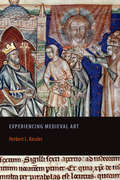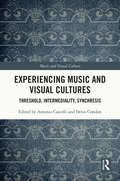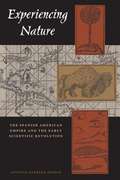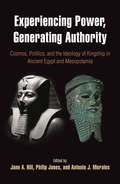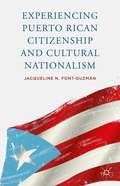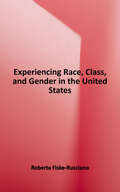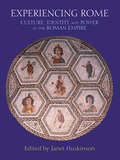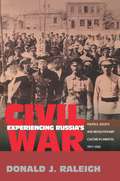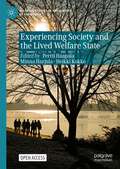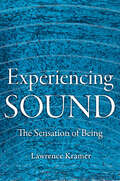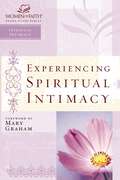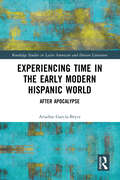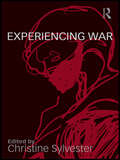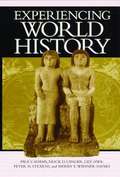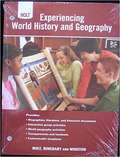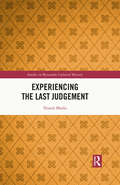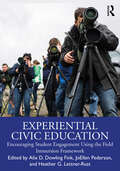- Table View
- List View
Experiencing Medieval Art (Rethinking the Middle Ages)
by Herbert L. KesslerExperiencing Medieval Art is an extensive revision and expansion of the author’s Seeing Medieval Art, originally published in 2004. Renowned art historian Herbert L. Kessler considers often-strange objects and the materials of which they are made, circumstances of production, the conflictual relationship between art objects and notions of an ineffable deity, the context surrounding medieval art, the playfulness of art and the formal movements it engaged, as well as questions of apprehension, aesthetics, and modern presentation. Kessler introduces the exciting discoveries and revelations that have revolutionized the understanding of medieval art and identifies the vexing challenges that still remain. Examining such well-known monuments as the stained glass in Chartres cathedral, mosaics in San Marco Venice, and Utrecht Psalter, as well as newly discovered works – including the frescoes in Rome’s "aula gotica" and a twelfth-century aquamanile in Hildesheim – Kessler makes the complex history of medieval art accessible for students of art history, teachers in the field, and scholars of medieval history, theology, and literature.
Experiencing Music and Visual Cultures: Threshold, Intermediality, Synchresis (Music and Visual Culture)
by Antonio Cascelli Denis CondonBringing the research of musicologists, art historians, and film studies scholars into dialogue, this book explores the relationships between visual art forms and music. The chapters are organized around three core concepts – threshold, intermediality, and synchresis – which offer ways of understanding and discusssing the interplay between the arts of sounds and images. Refuting the idea that music and visual art forms only operate in parallel, the contributors instead consider how the arts of sound and vision are entwined across a wide array of materials, genres and time periods. Contributors delve into a rich variety of topics, ranging from the art of Renaissance Italy to the politics of opera in contemporary Los Angeles to the popular television series Breaking Bad. Placing these chapters in conversation, this volume develops a shared language for cross-disciplinary inquiry into arts that blend music and visual components, integrates insights from film studies with the conversation between musicology and art history, and moves the study of music and visual culture forward.
Experiencing Nature: The Spanish American Empire and the Early Scientific Revolution
by Barrera-Osorio AntonioHe also conclusively links empiricism to empire-building as he focuses on five areas of Spanish activity in America: the search for commodities in, and the ecological transformation of, the New World; the institutionalization of navigational and information-gathering practices at the Spanish Casa de la Contratación (House of Trade); the development of instruments and technologies for exploiting the natural resources of the Americas; the use of reports and questionnaires for gathering information; and the writing of natural histories about the Americas.
Experiencing Old Age in Ancient Rome
by Karen CokayneOld age today is a contentious topic. It can be seen as a demographic timebomb or as a resource of wisdom and experience to be valued and exploited. There is frequent debate over how we value the elderly, and whether ageing is an affliction to be treated or a natural process to be embraced. Karen Cokayne explores how ancient Rome dealt with the physical, intellectual and emotional implications of the ageing process, and asks how the Romans themselves experienced and responded to old age. Drawing on a wide range of contemporary material - written sources, inscriptions, and visual evidence - the study brings into focus universal concerns, including geriatric illness, memory loss and senility; the status and role of the old, sexuality and family relationships. The book's unique emphasis on both the individual and society's responses to ageing makes it a valuable contribution to the study of the social history of Rome.
Experiencing Olmsted: The Enduring Legacy of Frederick Law Olmsted's North American Landscapes
by Charles Birnbaum The Cultural Landscape Foundation Dena Tasse-Winter Arleyn Levee200 Iconic Landscapes That Define North America Frederick Law Olmsted is the father of American landscape architecture. His firm, and the successor firms that sprung from it, worked through the nineteenth and twentieth centuries to shape some of our most beloved green spaces, including national, state, and city parks, suburban neighborhoods, and academic campuses. He is most famous for creating New York&’s Central and Prospect Parks, Stanford University&’s campus, and the Capitol Grounds. What is less known and surprising about his legacy is that he worked widely across North America. By highlighting 200 iconic landscapes, many of which are still open to the public today, Experiencing Olmsted brings a fresh approach to the firms&’ work and philosophy. It highlights not only grand city parks, but also other public venues born out of a desire for social equity. Olmsted was an early voice for parks as democratic spaces that could be reached on foot by a large percentage of any city&’s populace. He viewed parks as restorative places—what he termed &“the lungs of a city.&” Brimming with contemporary and archival photography as well as original drawings and plans, this truly remarkable record brings these places to vivid life.
Experiencing Poverty: Voices From The Bottom
by D. Stanley Eitzen Kelly Eitzen SmithThis collection of readings provides the voice, the presence, and the perspective of the poor who live on the margins and are generally invisible to the middle and upper classes. The goals of this reader are twofold: (1) to bring the realities of the lives of the impoverished as close to the reader as possible (2) to get the reader to listen carefully to these voices of the poor in order to enhance their understanding of: a. How the poor became poor. b. How the poor are treated by individuals and organizations in the community. c. What keeps the poor poor. d. How the poor manage day-to-day. e. What theory of causation best explains poverty. f. The consequences of the welfare-to-work federal legislation. g. The best solutions for ending poverty.
Experiencing Power, Generating Authority: Cosmos, Politics, and the Ideology of Kingship in Ancient Egypt and Mesopotamia
by Philip Jones Jane A. Hill Antonio J. MoralesFor almost three thousand years, Egypt and Mesopotamia were each ruled by the single sacred office of kingship. Though geographically near, these ancient civilizations were culturally distinct, and scholars have historically contrasted their respective conceptualizations of the ultimate authority, imagining Egyptian kings as invested with cosmic power and Mesopotamian kings as primarily political leaders. In fact, both kingdoms depended on religious ideals and political resources to legitimate and exercise their authority. Cross-cultural comparison reveals the sophisticated and varied strategies that ancient kings used to unify and govern their growing kingdoms.Experiencing Power, Generating Authority draws on rich material records left behind by both kingdoms, from royal monuments and icons to the written deeds and commissions of kings. Thirteen essays provocatively juxtapose the relationships Egyptian and Mesopotamian kings had with their gods and religious mediators, as well as their subjects and court officials. They also explore the ideological significance of landscape in each kingdom, since the natural and built environment influenced the economy, security, and cosmology of these lands. The interplay of religion, politics, and territory is dramatized by the everyday details of economy, trade, and governance, as well as the social crises of war or the death of a king. Reexamining established notions of cosmic and political rule, Experiencing Power, Generating Authority challenges and deepens scholarly approaches to rulership in the ancient world.Contributors: Mehmet-Ali Ataç, Miroslav Bárta, Dominique Charpin, D. Bruce Dickson, Eckart Frahm, Alan B. Lloyd, Juan Carlos Moreno Garcia, Ludwig D. Morenz, Ellen Morris, Beate Pongratz-Leisten, Michael Roaf, Walther Sallaberger, JoAnn Scurlock.PMIRC, volume 6
Experiencing Puerto Rican Citizenship and Cultural Nationalism
by Jacqueline N. Font-GuzmánDrawing from in-depth interviews with a group of Puerto Ricans who requested a certificate of Puerto Rican citizenship, legal and historical documents, and official reports not publicly accessible, Jacqueline Font-Guzmán shares how some Puerto Ricans construct and experience their citizenship and national identity at the margins of the US nation. Winner of the 2015 Juridical Book of the Year in the category of ‘Essay Promoting Critical Thinking and Analysis of Juridical and Social Issues.’
Experiencing Race, Class, and Gender in the United States, Seventh Edition
by Roberta Fiske-RuscianoThrough individual stories, essays, poetry, and critical analyses, Experiencing Race, Class, and Gender in the United States, Seventh Edition, introduces issues of race, class, and gender within an interdisciplinary framework. Divided into three sections, Identity, Power, and Change, as well as nine parts, Fiske-Rusciano challenges readers to reflect on their own lives, examine the structural systems that contribute to inequality, and identify problems while visualizing change. “Understanding the Reading” questions encourage critical thinking and classroom discussion, and “Suggestions for Responding” encourage further study. In addition to its focus on minorities victimized by discrimination, this anthology also includes the experiences of the privileged and of those who resist change and reinforces students’ understanding that they can create change in their lives and in society. New to This Edition: - Twenty-five new readings focus upon divisions in our understanding of U.S. history and the consequences of those divisions - New Part VII “Race, Class, and Gender During the Obama and Trump Administrations: A Comparative Look,” focuses on themes such as racial politics, women’s rights, environmental justice, and marginalization.
Experiencing Rome: Culture, Identity and Power in the Roman Empire
by Janet HuskinsonFirst published in 1999. Routledge is an imprint of Taylor & Francis, an informa company.
Experiencing Russia's Civil War: Politics, Society, and Revolutionary Culture in Saratov, 1917-1922
by Donald J. RaleighThis book is the only comprehensive history of the total experience of the Russian Civil War. Focusing on the key Volga city of Saratov and the surrounding region, Donald Raleigh is the first historian to fully show how the experience of civil war embedded itself into both the people's and the state's outlook and behavior. He demonstrates how and why the programs and ideals that had propelled the Bolsheviks into power were so quickly lost and the repressive Soviet party-state was born.Experiencing Russia's Civil War is based on exhaustive use of previously classified local and central archives. It is also bold and ambitious in its breadth of thematic coverage, dealing with all aspects of the war experience from institutional evolution and demographics to survival strategies. Complicating our understanding of this formative period, Raleigh provides compelling evidence that many features of the Soviet system that we associate with the Stalin era were already adumbrated and practiced by the early 1920s, as Bolshevism became closed to real alternatives. Raleigh interprets this as the consequence of a complex dynamic shaped by Russia's political tradition and culture, Bolshevik ideology, and dire political, economic, and military crises starting with World War I and strongly reinforced by the indelible, mythologized experience of survival in the Civil War.Fluidly written, replete with new information, and always engaged with important questions, this is history finely wrought.
Experiencing Society and the Lived Welfare State (Palgrave Studies in the History of Experience)
by Pertti Haapala Minna Harjula Heikki KokkoThis open access book presents a new approach to the history of welfare state. By applying the concepts of experiencing society and the lived welfare state, the collection introduces theoretical, methodological and empirical insights for bridging the everyday life and institutional structures. The chapters analyze how the welfare state as a particular individual-society relationship has become an integral part of living in the modern society. With a long-term perspective, the chapters explore the experience of society which enabled the building and the resilience of a welfare state. As the welfare state is not a universal model of social development but historically unique in different contexts, the book broadens the focus from the Nordic countries to Southern Europe, colonial Asia and post-colonial South America. This collection is essential reading for scholars and students in the social sciences and history, as well as for policymakers and practitioners who face the contemporary and future challenges of the welfare states.
Experiencing Sound: The Sensation of Being
by Lawrence KramerFrom the winds of Mars to a baby's first laugh, a prolific philosopher-composer reflects on the profound imperative of sound in everyday life. Experiencing Sound presents its subject as fundamental to all experience—sensation, perception, and understanding. Lawrence Kramer turns on its head the widespread notion that vision takes pride of place among the senses and demonstrates how paying attention to sound can transform how we make meaning out of experience. Through a series of brief, lyrical forays, Kramer shows that sound, whether heard or unheard, is the object of a primary need and an essential component in the sensation of being alive and the perception of time. It is something that we may suffer—or be made to suffer—as well as enjoy. Like its predecessor The Hum of the World, this book ranges widely across music, philosophy, literature, art, media, and history, from classical antiquity to the present, as it invites us to experience sound anew.
Experiencing Spiritual Intimacy: Women of Faith Study Guide Series (Women of Faith Study Guide Series)
by Christa J. Kinde Women of FaithWomen of Faith, renowned for their unique combination of personality and truth, offer fresh new messages in their fourth series of popular topical study guides. Titles include: Receiving God's Goodness Experiencing Spiritual Intimacy Contagious Joy Understanding Purpose Each study guide, teeming with insights and quotes from the conference speakers provides twelve weeks of Bible study, a leader's guide for small groups, and a special take-home reminder for each week's lesson.
Experiencing Time in the Early Modern Hispanic World: After Apocalypse (Routledge Studies in Latin American and Iberian Literature)
by Ariadna García-BryceThis book considers the new ways time was experienced in the 16th- and 17th-century Hispanic world in the framework of global Catholicism. It underscores the crucial role that the imitation of Christ plays in modeling how representative writers physically and mentally interiorize temporal impermanence as the Messiah’s suffering body becomes a paradigmatic as well as malleable marker of the avatars of earthly history. Particular attention is paid to the ways in which authors adapt Christ-centered conceptions of existence to accommodate both a volatile post-eschatological world and the increased dominance of mechanical clock time. As novel means of communing with Christ emerge, so too do new modes of sensing and understanding time, unleashing unprecedented cultural and literary reinvention. This is demonstrated through close analyses of writings by such influential figures as Saint Ignatius of Loyola, Saint Teresa of Ávila, Carlos de Sigüenza y Góngora, and Sor Juana Inés de la Cruz.
Experiencing War (War, Politics and Experience)
by Christine SylvesterThis edited collection explores aspects of contemporary war that affect average people –physically, emotionally, and ethically through activities ranging from combat to television viewing. The aim of this work is to supplement the usual emphasis on strategic and national issues of war in the interest of theorizing aspects of war from the point of view of individual experience, be the individual a combatant, a casualty, a supporter, opponent, recorder, veteran, distant viewer, an international lawyer, an ethicist or other intellectual. This volume presents essays that push the boundaries of war studies and war thinking, without promoting one kind of theory or methodology for studying war as experiential politics, but with an eye to exploring the possibilities and encouraging others to take up the new agenda. It includes new and challenging thinking on humanitarianism and war, new wars in the Third World, gender and war thinking, and the sense of the body within war that inspires recent UN resolutions. It also gives examples that can change our understanding of who is located where doing what with respect to war –women warriors in Sierra Leone, war survivors living with their memories, and even an artist drawing something seemingly intangible about war –the arms trade. The unique aspect of this book is its purposive pulling together of foci and theoretical and methodological perspectives from a number of disciplines on a variety of contemporary wars. Arguably, war is an activity that engages the attention, the politics, and the lives of many people. To theorize it with those lives and perspectives in mind, recognizing the political contexts of war, is long overdue. This inter-disciplinary book will be of much interest to students of war studies, critical security studies, gender studies, sociology and IR in general.
Experiencing World History
by Peter N. Stearns Merry E. Wiesner-Hanks Paul Vauthier Adams Erick D. Langer Lily HwaCovering early societies, the classical, post classical, and modern periods, and the 20th century, and blending the great advances in historical research over the past quarter century,Experiencing World History represents an important addition to the teaching of world history. Focusing on major issues in social history in the context of world history and divided into five chronological sections that highlight the mixture of change and continuity, the volume traces key aspects of society over time, among them gender; work and leisure; state and society; culture contact and population patterns. Truly global in scope,Experiencing World Historyincludes deep coverage of all the major areas including Asia, Africa, Europe, and the Americas. A brief introduction ties the social history themes to more conventional world history coverage, and an epilogue after each of the five sections suggests overarching themes and connections.
Experiencing World History
by Peter N. Stearns Merry E. Wiesner-Hanks Paul Vauthier Adams Lily Hwa Erick Detlef LangerCovering early societies, the classical, postclassical, and modern periods, and the 20th century, and blending the great advances in historical research over the past quarter century, Experiencing World History represents an important addition to the teaching of world history. Focusing on major issues in social history in the context of world history and divided into five chronological sections that highlight the mixture of change and continuity, the volume traces key aspects of society over time, among them gender; work and leisure; state and society; culture contact and population patterns. Truly global in scope, Experiencing World History includes deep coverage of all the major areas including Asia, Africa, Europe, and the Americas. A brief introduction ties the social history themes to more conventional world history coverage, and an epilogue after each of the five sections suggests overarching themes and connections.
Experiencing World History and Geography
by Holt Winston RinehartActivities for Holt World History: Experiencing World History and Geography, High School
Experiencing World History and Geography: Experiencing World History And Geography (Holt World History Ser.)
by Holt Winston RinehartActivities for Holt World History: Experiencing World History and Geography, High School
Experiencing the Last Judgement (Studies in Byzantine Cultural History)
by Niamh BhallaExperiencing the Last Judgement opens up new ways of understanding a Byzantine image type that has hitherto been considered largely uniform in its manifestations and to a great extent frightening, coercive and paralysing. It moves beyond a purely didactic understanding of the Byzantine image of the Last Judgement, as a visual eschatological text to be ‘read’ and learned from, and proposes instead an appreciation of each unique image as a dynamic site to be experienced. Paintings, icons and mosaics from the tenth to the fourteenth century, from inside and outside of the Byzantine Empire, are placed within their specific socio-historical milieus, their immediate decorative programmes and their architectural contexts to demonstrate that each unique image constituted a carefully orchestrated and immersive experience of judgement. Each case study outlines the differences that exist in reality between these images that are often subsumed under one iconographic label, making a case against condensing dynamic, lived images into apparently static pictorial ‘types’. Images of the Last Judgement needed the body, mind and memory of the viewer for the creation of meaning, and so the experience of these images was unavoidably spatial, gendered, corporeal, mnemonic, emotional, rhetorical and most often liturgical. Unpacking Byzantine images of judgement in light of these various facets of experience for the first time helps to elucidate the interaction of past individuals with the image, and the ways in which such encounters were intended to benefit the communities that made and lived alongside them.
Experiencing the Thirty Years War: A Brief History With Documents
by Hans Medick Benjamin MarschkeOne of the most momentous and destructive wars in European history, the Thirty Years War has long been studied for its diplomatic, political, and military consequences. Yet the actual participants in this religiously motivated, seemingly endless conflict have largely been ignored. Hans Medink and Benjamin Marschke reveal the Thirty Years War from the perspective of those who lived it. Their introduction provides important insights into the roiling religious and political landscape from which the war emerged, as well as a thoughtful examination of the war's stages and enduring significance. An unprecedented collection of personal accounts, many of them translated for the first time into English, combine with visual sources to convey directly to students the experience of early modern warfare. Incisive document headnotes, maps and illustrations, a chronology, questions to consider, and a bibliography enrich students' understanding of this fateful war.
Experiential Civic Education: Encouraging Student Engagement Using the Field Immersion Framework
by JoEllen Pederson Lettner-Rust, Heather G.Experiential Civic Education: Encouraging Student Engagement Using the Field Immersion Framework articulates a practical, flexible teaching-and-learning pedagogy that engages students and instructors in opportunities to successfully explore complex civic issues in the classroom. This volume marries place-based experiential learning with civic engagement to promote important transformative learning outcomes.The Field Immersion Framework (FIF) pedagogy prepares students and faculty with the tools to navigate participatory democracy in local, state, national, and global communities. The FIF uses four stages – Foregrounding, Immersion, Reflection, and Civic Agency – to position learners as explorers and researchers in communities grappling with important societal issues. In this volume, Foregrounding chapters prime the reader with the theoretical support to explore the content; Immersion chapters situate the reader in case studies of FIF courses; Reflection chapters showcase the voices of students, faculty members, student affairs professionals, and others who have participated in these courses; and, finally, Civic Agency chapters explore the implications of the FIF.This book will be important reading for those developing courses relating to civic engagement, social justice education, and community-based teaching and learning. It also supports educators in exploring place-based civic issues with their students, working to encourage understanding of diverse voices and perspectives, and supporting students’ lifelong navigation of our complex world.
Experiential Spectatorship: Immersion, Participation, and Play During Times of Deep Mediatization (Audience Research)
by William W. LewisExperiential Spectatorship offers a lens for analyzing audience experience with(in) a variety of contemporary media. Using a broad-based perspective, this media includes participatory theatre, video games, digital simulations, social media platforms, alternate reality games, choose your own adventure narratives, interactive television, and a variety of other experiential performance events. Through a taxonomy that includes Immersion, Participation, Game Play, and Role Play the book guides the reader to understand the ways mediatization and technics brought about by digital technologies are changing the capacities and expectations of contemporary audiences. In their daily interactions and relations with their technologies, they become mediatized spectators. By reading these technologies' impacts on individual subjectivity prior to acts of spectatorship, one gains the tools to best describe how the spectator creates forms of relational exchange with their experential media.This book prepares the reader to think in a digital manner so they can best recognize how performance and spectatorship in the twenty-first century are evolving to meet the needs of future waves of spectators brought up in a postdigital world.
Experiment and Tradition in Primary Schools (Routledge Revivals)
by D.E.M. GardnerFirst published in 1966, Experiment and Tradition in Primary Schools was written to provide an account of the author’s pioneering study of the attainment of young children in schools where the curriculum was shaped by their spontaneous interests. The book describes the findings of Gardner’s work and assesses them in detail. It will have lasting relevance for those with an interest in the history of education and the development of education in infant and junior schools.
